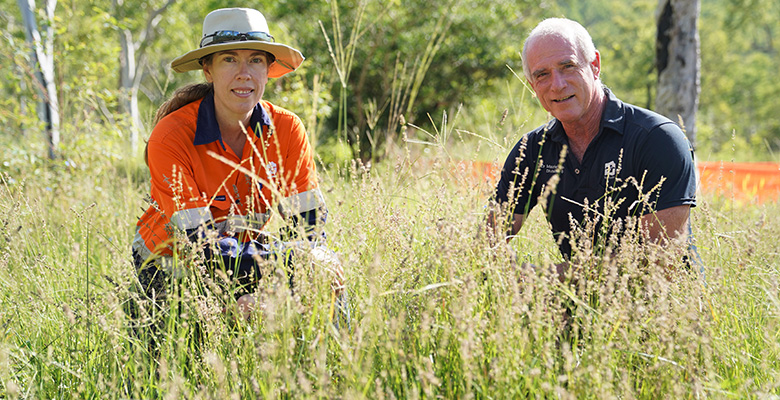Revegetation project success after recent rain
Date published: 14 February 2022
A revegetation project undertaken at Oak Valley last year has successfully provided an abundance of native grasses for the endangered black-throated finch.
The project, led by Townsville City Council environmental restoration and ecology officers with assistance from volunteers from Skilling Queenslanders for Works and Coastal Dry Tropics Landcare Inc, saw the planting of more than 1,000 native grasses.
Community Health, Safety and Environmental Sustainability Chairperson Maurie Soars said the objective of the program was to improve the availability of native grass seeds which are eaten by the endangered species.
“Townsville is very lucky to be one of the remaining areas where the southern sub-species of the black-throated finch can still be found. Council officers have worked tirelessly to increase the availability of foraging grasses in the reserve for the endangered species,” Cr Soars said.
“After the recent seasonal rain, it’s fantastic to see an abundance of native grass in the area, particularly after all the hard work many have put in over the last 18 months.
“The revegetation project included the planting of a number of native grass species, including Cockatoo Grass, Golden Beard Grass, and Clustered Love Grass, to increase the amount of suitable grass seeds available to the endangered finch.”
Cr Soars said over the last 18 months several projects had been completed in the Oak Valley Nature Reserve to assist the protection of the black-throated finch habitat.
“These projects include the revegetation of over 1,000 native grasses, planting of trees to assist in erosion control along Sachs Creek, clearing of invasive weeds and the installation of a water trough to provide a year-round water source for the finches,” he said.
“These native grasses are a food source for the black-throated finch and will increase their access to native grass seed, with the water trough providing access to water during the dry period when Sachs Creek typically runs dry.
“Additionally, the planting of the native grasses and clearing of high-priority weeds will assist in supressing weed growth in the area.
“This work is ongoing, with Council planning to plant another 1000 native grass tube stock this month.
“Our officers will continue to work to maintain and protect this site and many others throughout Townsville.”
CDTLI Project Officer Tasha Rodwell said Landcare has been working together with Council to propagate the grasses needed to deliver this project.
“Our staff and volunteers at our Bush Garden Nursery have been working closely with the Council to propagate the native grasses used in the Oak Valley Revegetation Project,” Ms Rodwell said.
“CDTLI specialise in the propagation and supply of native provenance species and it is always so rewarding to see how these plants contribute to the restoration of eco-system function and bring back biodiversity into the local region – in this case focusing on the endangered black-throated finch.”
Cr Soars said the Oak Valley Reserve was identified because it borders already existing black-throated finch habitat.
“In recent decades, the range of the black-throated finch has shrunk by 80 per cent – with the species no longer found in NSW – due to clearing and modification of its habitat,” he said.
“The main factors contributing to the decline in the black-throated finch include land clearing, introduction of invasive weeds, decline in native grass seed availability, decreased access to year around water sources, and predators.”






